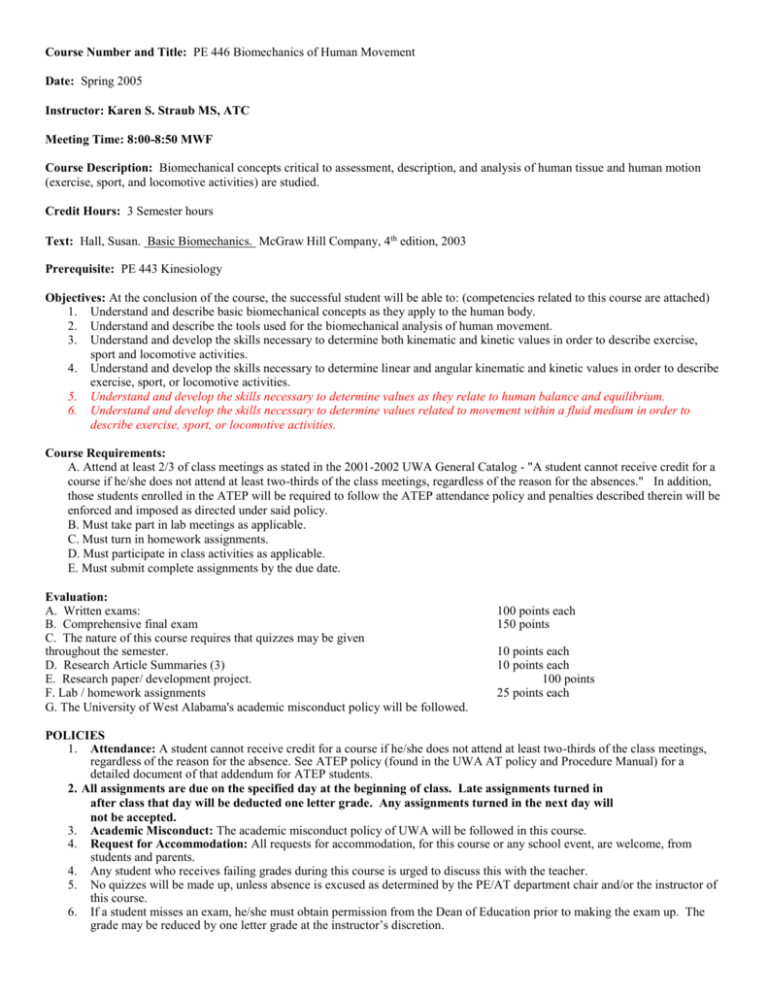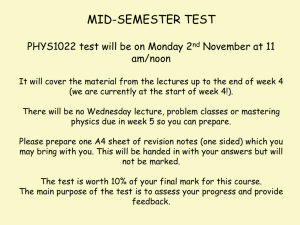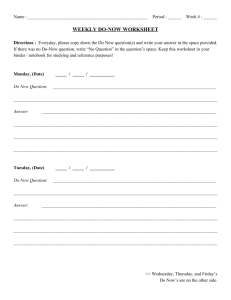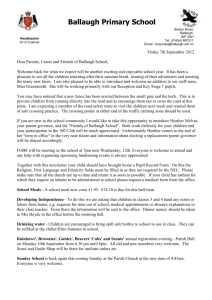
Course Number and Title: PE 446 Biomechanics of Human Movement
Date: Spring 2005
Instructor: Karen S. Straub MS, ATC
Meeting Time: 8:00-8:50 MWF
Course Description: Biomechanical concepts critical to assessment, description, and analysis of human tissue and human motion
(exercise, sport, and locomotive activities) are studied.
Credit Hours: 3 Semester hours
Text: Hall, Susan. Basic Biomechanics. McGraw Hill Company, 4th edition, 2003
Prerequisite: PE 443 Kinesiology
Objectives: At the conclusion of the course, the successful student will be able to: (competencies related to this course are attached)
1. Understand and describe basic biomechanical concepts as they apply to the human body.
2. Understand and describe the tools used for the biomechanical analysis of human movement.
3. Understand and develop the skills necessary to determine both kinematic and kinetic values in order to describe exercise,
sport and locomotive activities.
4. Understand and develop the skills necessary to determine linear and angular kinematic and kinetic values in order to describe
exercise, sport, or locomotive activities.
5. Understand and develop the skills necessary to determine values as they relate to human balance and equilibrium.
6. Understand and develop the skills necessary to determine values related to movement within a fluid medium in order to
describe exercise, sport, or locomotive activities.
Course Requirements:
A. Attend at least 2/3 of class meetings as stated in the 2001-2002 UWA General Catalog - "A student cannot receive credit for a
course if he/she does not attend at least two-thirds of the class meetings, regardless of the reason for the absences." In addition,
those students enrolled in the ATEP will be required to follow the ATEP attendance policy and penalties described therein will be
enforced and imposed as directed under said policy.
B. Must take part in lab meetings as applicable.
C. Must turn in homework assignments.
D. Must participate in class activities as applicable.
E. Must submit complete assignments by the due date.
Evaluation:
A. Written exams:
B. Comprehensive final exam
C. The nature of this course requires that quizzes may be given
throughout the semester.
D. Research Article Summaries (3)
E. Research paper/ development project.
F. Lab / homework assignments
G. The University of West Alabama's academic misconduct policy will be followed.
100 points each
150 points
10 points each
10 points each
100 points
25 points each
POLICIES
1. Attendance: A student cannot receive credit for a course if he/she does not attend at least two-thirds of the class meetings,
regardless of the reason for the absence. See ATEP policy (found in the UWA AT policy and Procedure Manual) for a
detailed document of that addendum for ATEP students.
2. All assignments are due on the specified day at the beginning of class. Late assignments turned in
after class that day will be deducted one letter grade. Any assignments turned in the next day will
not be accepted.
3. Academic Misconduct: The academic misconduct policy of UWA will be followed in this course.
4. Request for Accommodation: All requests for accommodation, for this course or any school event, are welcome, from
students and parents.
4. Any student who receives failing grades during this course is urged to discuss this with the teacher.
5. No quizzes will be made up, unless absence is excused as determined by the PE/AT department chair and/or the instructor of
this course.
6. If a student misses an exam, he/she must obtain permission from the Dean of Education prior to making the exam up. The
grade may be reduced by one letter grade at the instructor’s discretion.
POLICY ON ACCOMMODATION FOR INDIVIDUALS WITH DISABILITIES
The University of West Alabama strives to make its programs accessible to qualified persons defined as disabled under Section 504 of
the Rehabilitation Act of 1973 and the Americans with Disabilities Act. Students who have special needs that require accommodation
are responsible for notifying instructors in each course in which they are enrolled and appropriate staff members, who in turn will
refer to the student to the ADA Compliance Coordinator. Following verification of the student's status, the ADA Compliance
Coordinator will work with the instructor or staff member in implementing an
appropriate plan for accommodation of the student's needs. Support documentation of special needs form a physician or other
qualified professional will be required if deemed necessary.
For additional information, students should contact Student Success Center, Foust Hall 7, (205) 652- 3651 or the Office of Student
Life 31 1, Webb Hall, (205 652-3581.
Calendar-. This calendar is a temporary guideline and may change, as the instructor deems necessary or coursework dictates.
Students will not attend class on Assessment Day: March 15, 2005, & Spring Break: March 28-April 1, 2005.
Commencement: Saturday, May 7, 2005
Monday
1/10
Wednesday
Friday
Monday
Wednesday
1/12
1/14
1/17
1/19
Friday
Monday
Wednesday
1/21
1/24
1/26
Friday
Monday
Wednesday
Friday
Monday
Wednesday
Friday
Monday
Wednesday
1/28
1/30
2/2
2/4
2/7
2/9
2/11
2/14
2/16
Friday
Monday
Wednesday
2/18
2/21
2/23
Friday
Monday
Wednesday
Friday
Monday
Wednesday
Friday
Monday
Wednesday
Friday
Monday
Wednesday
Friday
2/25
2/28
3/2
3/4
3/7
3/9
3/11
3/14
3/16
3/18
3/21
2/23
2/25
Monday
Wednesday
Friday
4/4
4/6
4/8
Review of Syllabus and Assignments, begin Unit I: Basics
or Biomechanics
Principles and Concepts: basics & movement terminology
Reference systems
MLK Day – No classes
Math review continued/ Joint movements; Article I
(training and conditioning) due
Basics (a-e)– Karen at Educator’s Conference
Basics (e-i)
end Test I material/- review
Begin Unit II: Loading of Human Tissue
Test I
Mechanical loading
Loading of Bone
Loading of Bone / Articulations
Loading of Articulations / Ligaments & tendons
Loading of Ligaments & tendons/ Muscle
Loading of Muscle
Loading of Nerves
Review of Unit II/ Begin Unit III: Biomechanics in Life
and Sports
Test II
Biomechanics in Linear Motion
Linear Motion ; Article 2 (injury of specific sports
technique analyzed) due
Biomechanics in Angular Motion
Angular Motion
Biomechanics in Stability
Stability
Biomechanics in Fluid Mediums
Fluid Mediums
Review Test III/ Begin Unit IV: Biomechanics in Action
Test III
Biomechanics of the upper extremity
Upper Extremity/ analyzing on the field
Biomechanics of the lower extremity
Lower extremity/ analyzing on the field
Biomechanics of the spine ; Research paper/project Due
March 28-April 1 Spring Break NO CLASSES
Spine / analyzing on the field
Analyzing skills
Analyzing skills; Article 3 (different injury of specific
sports technique analyzed) due
Ch 1
Ch 2
Ch 2
Ch 3
Ch 4
Ch 5/Supplement
Supplement/Ch 6
Ch 6
Supplement
Ch 10
Ch 12
Ch 11
Ch 14
Ch 13
Ch 15
Ch 7
Ch 8
Ch 9
Monday
Wednesday
Friday
Monday
Wednesday
Friday
Monday
Wednesday
Friday
4/11
4/13
4/15
4/18
4/20
4/22
4/25
4/27
4/29
Mechanics of Selected Skills
Mechanics of Selected Skills
Identifying and correct errors
Identifying and correct errors
Applying to activities / using in your career
Applying to activities / using in your career
Applying to activities / using in your career
Review for final –Last Day of classes
Final Exam is from 8AM- 10AM
Assignments Explained
Articles
You must select 3 articles (see above schedule for topics) throughout the semester to summarized and use biomechanics to agree of
disagree with the author on the subject. For example, in choosing an article about specific tackling techniques in football, you may
agree or disagree with the authors of the articles method but you must use a concept or application from the coursework to support
your response.
The article response can be no less that 1 page double spaced 10 point font with margins not to exceed 1 inch on any side, top
or bottom of the page.
In addition, your name, article number, “PE 446” and the articles citation in APA format (refer to the UWA Library writing
help page for details on AP format)will be the only items present besides the summary / response, allowing for only 1 “10
point font” space between these items and your response begins.
You may submit the response typed in class or may e-mail the response to kstraub@uwa.edu – but must be received by 8am
on the due date or no credit will be awarded regardless of reason.
You must ask any questions on the format prior to the due date and incorrect or improperly formatted articles will receive no
credit. Articles are due by class time on the date indicated on the schedule above.
Articles must be from legitimate sources(professional journals, etc) and cannot be form popular magazines or internet based
sources. The responsibility of an appropriate source falls to the student - if you an unsure of the validity of a potential source,
it is strongly recommended you check the source with the instructor prior to completing the assignment. No second attempts
for inappropriate sources will be allowed
No copy of the journal article is required. However, the instructor will verify the articles existence and appropriateness using
the APA citation you provide; if the instructor is unable to locate your article using usual means, you may be awarded no
credit. If the instructor locates the article and the sources is considered inappropriate ( popular magazine, internet based
source, etc) , you may receive no credit on the assignment. You may however print out a copy in the instance your article is
questioned and provide it to the instructor at that time.
Article must be within the last 15 years (1990-2005). Older articles will receive no credit.
Research Project / Paper
Each student must choose a specific sports skill or rehabilitation technique for analysis. In this analysis, the student must review the
motions of the complete skill (using anatomical terms) and the major human tissues involved (muscles, joints, etc). A detailed
breakdown of the skill includes the “nuances” that make an athlete /person more effective and at least 2 medical or sport skill
pathologies that are common with this skill. (this may be injuries of a compensation that is common and results n less effective
movement / skill)
The paper must be between 4-7 pages in length, double spaced in 12 point font. 1 Inch margins on the sides, top and bottom
is all that is permitted. A title page in any format must proceed the text of the paper. & the text will begin at the tope of the
first page.
NATA EDCUATIONAL COMPETENCIES
PATHOLOGY OF INJURIES AND ILLNESSES
Cognitive Domain
12 - Defines tissue lesions by body system in terms of etiology, pathogenesis, pathomechanics, treatment options, and expected
outcomes.
ASSESSMENT AND EVALUATION
Cognitive Domain
5 - Defines the principles and concepts of body movement including functional classification of joints, joint biomechanics, normal
ranges of joint motion, joint action terminology, muscular structures responsible for joint actions (prime movers, synergists), skeletal
muscle contraction, and kinesthesis/proprioception.
THERAPEUTIC EXERCISE
Cognitive Domain
7 - Describes the mechanical principles applied to the design and use of rehabilitation or reconditioning exercise equipment
(leverage, force).
(C) 1999, National Athletic Trainers' Association. All rights reserved.
NATA EDUCTAIONAL PROFIEICNIES
PROFICIENCIES INSTRUCTED: NONE
PROFICIENCIES EVALUATED:NONE




